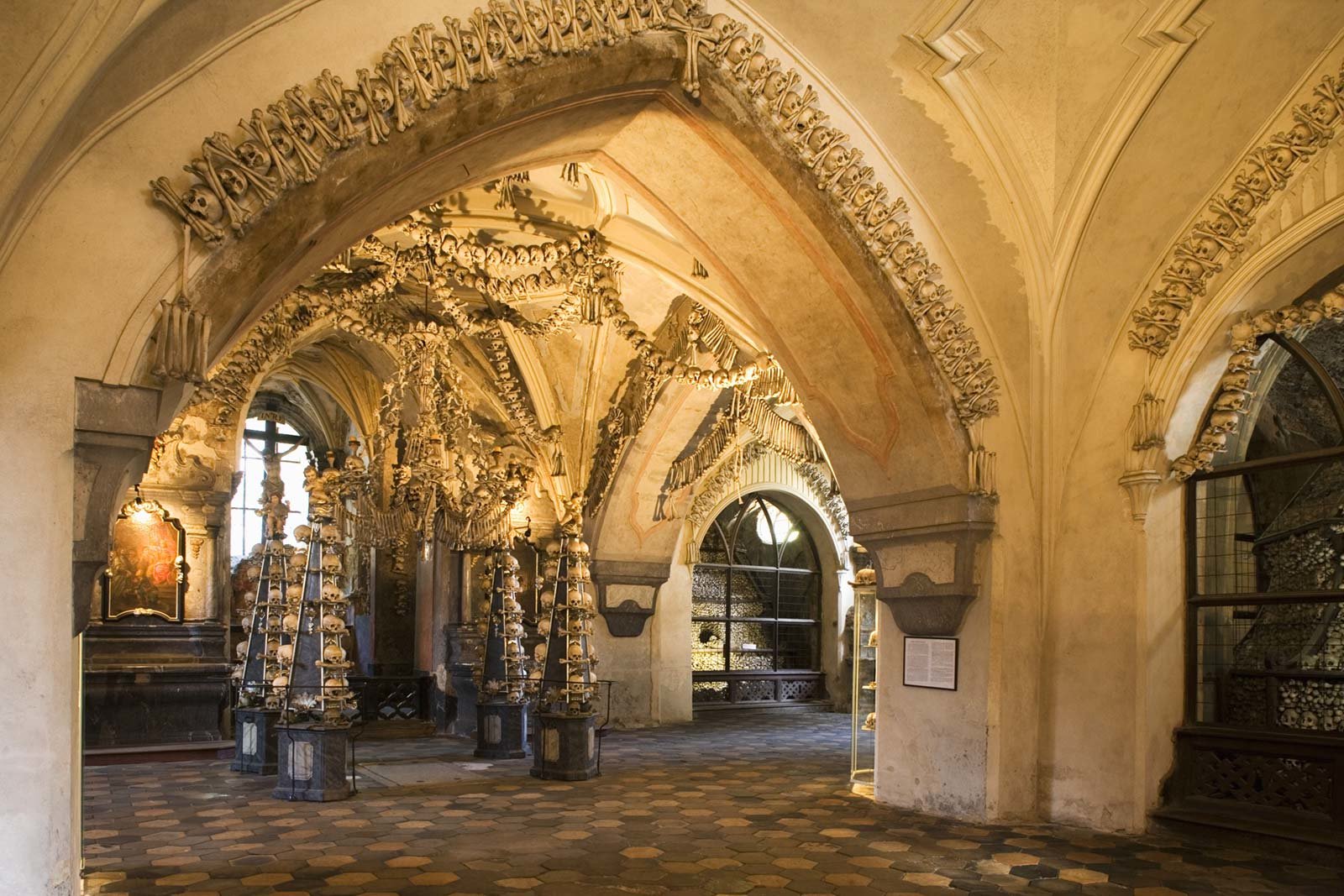Halloween may be in October, but for anyone with a passport and a strong constitution, the thrill of visiting a truly scary location can happen any time of the year.
These aren’t kitschy haunted houses or charming inns with sordid pasts. Instead, the most frightening places on Earth are truly unnerving—and they’ll often put you in the presence of literal (rather than supernatural) death.
Paris’s catacombs, for example, may be a popular tourist destination—but being surrounded by the bones of more than 6 million skeletons is still entirely frightening.
And just the journey to Dargavs—a collection of quaint, Nakh-style crypts—is harrowing. Travelers must brave a three-hour drive along twisting mountain roads in southern Russia. Fog is known to rapidly flood the valley and overtake visitors seeking the City of the Dead.
You can frighten yourself silly on a global ghost hunt, or simply pay your respects to the past. Either way, the 13 scariest places on Earth are not for the faint-hearted.

Island of Dolls in Mexico City
Just south of Mexico City, surrounded by the Xochimico canals, lies a small island with a dark history. The island’s caretaker, Don Julian Santana Barrera, discovered the body of a young girl who had drowned in the deep waters. When he later found a doll floating in the same water, he hung it in one of the island’s many trees to placate the dead child’s spirit, who was haunting his nightmares. Barrera continued to hang dolls or their parts—heads, limbs, even doll eyes—in the trees, slowly filling the island with his dolls. Eventually the island became known as Isla de las Muñecas, Island of the Dolls, and visitors would come to gawk at Barrera’s haunting work. Barrera persisted with his unsettling pastime for 50 years until he, too drowned in the canals.

Leap Castle in Ireland
This Irish castle has been frightening people since the 15th century, when a priest was brutally murdered in his own chapel by his brother in front of their family. In addition to the aptly-named Bloody Chapel, rumors suggest the entire grounds are haunted by a collection of frightening spirits, including one known only as the Elemental. One of the eeriest features of the castle is the oubliette, or murder hole, where prisoners were left to die and be forgotten. When workers discovered Leap Castle’s spike-lined oubliette, they uncovered three cart-loads of human remains inside. Their spirits, along with countless others murdered over the course of the castle’s long and bloody history, have given Leap Castle an unsavory reputation.

Hanging Coffins of Sagada in the Philippines
Visitors to Sagada, in the highlands of the Philippines, will see beautifully terraced hills, lush foliage, and coffins hammered into the sides of cliffs. Instead of burying their dead, the local Igorot people believe leaving the caskets above ground allows for easier passage to heaven (while also keeping the deceased safe from floods and wild animals). Because the Igorot don’t fear death the way many Westerners do, many members of this tribe carve their own coffins in preparation. While they may not be unsettled by the site of coffins and the dead, that doesn’t mean visitors won’t be stricken by the sight. To add to your terrifying tour of the Philippines, take a trip to the Timbak Caves near Kabayan to see the Fire Mummies, which have remained in their burial caves for hundreds of years.

Hill of Crosses in Lithuania
On the outskirts of Šiauliai, in northern Lithuania, sits an ominous looking outcropping filled with crosses large and small, simple and ornate. The Hill of Crosses began in the wake of a rebellion against the Russian tsar that left hundreds dead. Relatives of the fallen rebels had no bodies to bury, so instead they left crosses to mark the passing of their loved ones. During Communist rule when religion was forbidden, the tradition continued under the cover of night, with people marking losses and making prayers at the crosses. Now more than 200,000 crosses fill the site, along with rosaries, pictures of saints, and handwritten prayers. It makes for an eerie place, despite the Pope’s sentiment that the Hill of Crosses was a place for hope, peace, love, and sacrifice.

Poveglia in Italy
When the plague started to tear through Venice, governors decided to quarantine the victims on the small island of Poveglia in the Venetian lagoon. It’s estimated that as many as 160,000 plague victims lived and died on the island between 1793 to 1814. Since then, mass graves have been unearthed. Poveglia also housed a mental hospital from 1922 to 1968, and the chief psychologist was rumored to have tortured and killed many of his patients. He eventually went mad with the guilt and threw himself from the island’s belltower. Reports say it wasn’t the fall that killed the psychologist, but a ghostly fog that rolled in and strangled him.

Aokigahara Forest in Japan
Since the 1950s, more than 500 people have traveled to the foot of Mount Fuji to commit suicide. It’s believed that demons and spirits walk among the dense trees and dark shadows of the Aokigahara forest, also known as the Sea of Trees. Other say it’s the trees themselves that have absorbed all the malevolent energy. As the death toll continues to mount, officials have filled Aokigahara forest with signs urging people to choose life over death.

Sanctuary of Tophet in Tunisia
The Roman historian Diodorus spun a gruesome tale of Carthaginians killing their own children as a sacrifice to the gods. Historians thought his words were simply anti-Carthage propaganda, until they uncovered the Sanctuary of Tophet filled with thousands of tiny bones. While archeologists were reluctant to believe the Carthaginians would murder their own young, the evidence was in the Tophet. “It is overwhelming and, we believe, conclusive: they did kill their children,” an ancient history professor told The Guardian. Adding to the horror, richer families were known to buy children from the poor and offer them to satisfy the gods’ bloodlust. Today, there are more than 20,000 urns containing the ashes of young children no older than four. Visitors who dare can tour the labyrinthine Sanctuary.

City of the Dead in Dargavs, Russia
In the state of North Ossetia-Alania, near Russia’s border with Georgia, is a charming village with modest stone houses that dot the foothills. Known as the city of Dargavs, this idyllic hamlet in a Caucasus Mountain ridge is home only to the dead. The homes are crypts filled with the bones of the surrounding city’s departed residents, buried with all their clothes and personal belongings. Known as the City of the Dead (title that dates back to the 14th- century) locals warn that visitors to the necropolis are cursed.

The Catacombs in Paris
Far below the streets of the City of Light are 200-miles of underground tunnels filled with the bones of deceased Frenchmen. The catacombs were built when Paris’s graveyards were overflowing tombs and mausoleums, and city officials decided to bury bodies underground. It’s believed that between six and seven million people have Les Catacombes as their final resting place. Their skulls are stacked in neat piles that line the pathways winding beneath Paris. While only a small portion of the labyrinth is open to the public, the area known as Denfert-Rochereau Ossuary is gruesome enough to scare even the most audacious visitor.

Sedlec Ossuary in Czech Republic
A small, Gothic church in Sedlec, near Kutna Hora in the Czech Republic, houses the bones of some 40,000 people who, in life, wanted to ensure quick ascension to the afterlife. A local woodcarver was hired to transform the bones into chandeliers, buntings, candleholders, and even a coat of arms to decorate the Sedlec Ossuary in macabre artwork. In an almost celebratory fashion, garlands of skulls crisscross the ceiling. Perhaps surprisingly, this isn’t the world’s only bone church. Visit the Chapel of Bones (Capela de Ossos) in Evora, Portugal, which contains the bones of 5,000 monks and features two bodies, one of a child, dangling from the ceiling.

Tuol Sleng Genocide Museum in Cambodia
During Cambodia’s long, bloody war, the Khmer Rouge turned a former Phnom Penh high school into a prison where an estimated 20,000 people were tortured or killed. At Pol Pot’s secret prison, captives were tortured into confessing to crimes they didn’t commit or forced to name associates. Now the prison has a third life as the Tuol Sleng Genocide Museum, where visitors can pay respects to the deceased. The museum reminds visitors to learn from the past—and the ghosts that are said to haunt the space help with that mission.

Chauchilla Cemetery in Peru
Peru’s Nazca people would bury their dead fully clothed and brightly painted, placing them in a mud and brick tomb for their journey to the afterworld. In the 1920s, archeologists unearthed the mummies that now fill Chauchilla Cemetary, which were incredibly well preserved by Peru’s dry climate. While the mummies are more than 1,000 years old, many still have hair, skin, teeth, and clothing. They sit upright in their graves with their skulls staring blankly at visitors. Over the years, grave robbers plundered the necropolis, stealing earthly possessions and scattering human remains across the site.

The Stanley Hotel in Colorado
A spooky night at The Stanley Hotel served as the inspiration for horror master Stephen King’s terrifying tale, The Shining, which was turned into the ultimate horror flick by Stanley Kubrick. Ever since the movie debuted in 1980, ghost-loving tourists have flocked here looking for the spirits of the hotel’s first owners, Flora and F.O. Stanley. With the new addition of a hedge maze to the grounds, the hotel’s chilling look is complete. For visitors seeking thrills, the hotel hosts late night paranormal investigations, and offers ghost adventure packages lead by experts in the supernatural.













